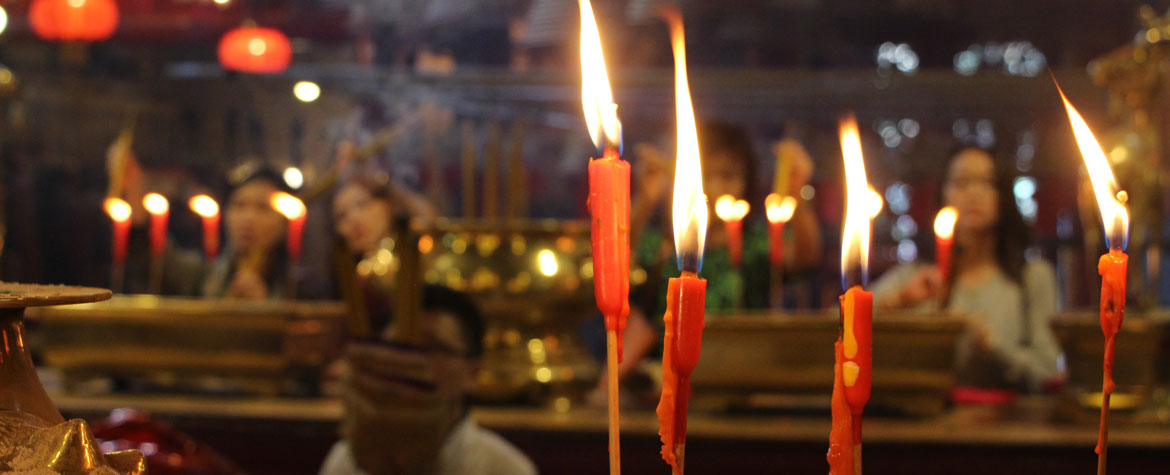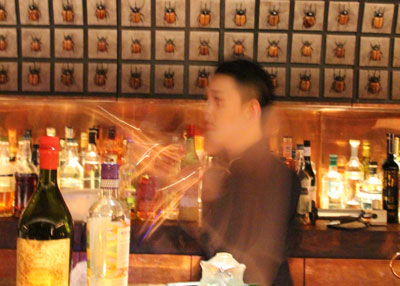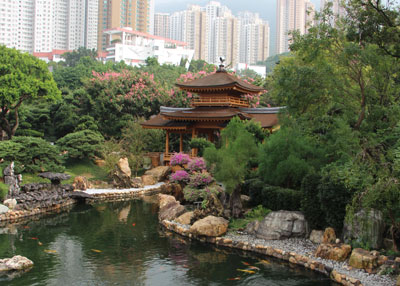
A vibrant heartbeat
Monica Tischler absorbs Hong Kong's history, culture and cuisine.
Closing my eyes, I silently pose a question to Buddha and shake the container of fortune sticks.
The air inside the temple is thick with incense smoke. It furls through the daylight, stinging my eyes and the back of my throat. I keep shaking – each brittle bamboo stick marked with a number from 1 to 100 – up, down, up, down, until finally one falls to the floor. Number 31 – a fair fortune; prosperity and happiness lie ahead.
The Kau Cim or lottery poetry is a fortune telling practice originating from China. It’s often performed in Buddhist temples, including Hong Kong’s Man Mo Temple, where I’m visiting today.
I’ve spent the morning walking the city, through Old Town Central, along Possession Street where British soldiers landed in 1841 to claim Hong Kong, then along Hollywood Road. I’m captivated by bright street art; a graffiti-style Marilyn Monroe blows a kiss from the side of a building. In the old days, Chinese brought goods here from over the border to sell and trade with the British. Today, it’s an art hub, with galleries and antique shops everywhere. Hong Kong constantly intrigues with its juxtaposition of history meeting contemporary.

I pass a street artist painting dragonflies onto tissue with a calligraphy brush dipped in black ink. “Enjoy your freedom,” he says, gifting me his work.
Foreign smells tease my nostrils as I wander Pottinger Street, nicknamed ‘Stone Slab Street’ referring to uneven cobblestones that help with hiking its steep gradient. Market stalls line either side and there’s only a narrow walking space. Floral scents from flower stands mix with whiffs of smoke from street food cooking nearby. Spicy notes from buckets of herbs combine with the aroma of dried seaweed and hanging meat.
I pass a stall selling traditional Chinese zodiac charms. The kiosk owner hands me a trinket intricately carved from stone; the ‘helping zodiac’ to my star sign, the horse. I should carry it in my handbag for luck and guidance, he says.
It’s the culture and superstition hidden down alleyways and behind temple walls that I grow to love about Hong Kong. It’s the gardens complete with ponds animated with schools of goldfish and lotus flowers and pagodas shrouded beneath high-rise buildings that give the city its heartbeat.
The iconic 128-year-old tram chugs up Victoria Peak. Reaching the top, I gain perspective on the scale of the city. I’m stunned by the high-density homogenized living in this crazy, hazy concrete jungle that’s home to more than seven million people. Stretching as far as I can see stand rows of high-rise buildings framed by the picturesque Victoria Harbour.
I don’t need to look far in Hong Kong for more culture and history colliding. Now lush green gardens, Kowloon Walled City Park was once a maze of illegally constructed buildings occupied by more than 33,000 people. Everything from drug trafficking, prostitution and unlicensed dentistry took place within its rickety walls until it was demolished by the government.
A walk through Chi Lin Nunnery and Nan Lian Garden complete with Buddhist temples and lotus ponds is refreshing in the humidity; a jaunt on the Aqua Luna, a traditional junk boat on Victoria Harbour, provides a dose of ocean air.

Satisfied with exploring Hong Kong Island, Central and surrounds, I lace up my walking shoes, hail a cab, and head for Sai Kung on the eastern peninsula to hike a section of the MacLehose Trail. Getting there by taxi is a good option as buses aren’t permitted near the trail entrance. The walk, listed by National Geographic as one of the world’s best, reveals panoramic views of the High Island Reservoir East Dam, green hills, volcanic rock formations and a stunning drop-off to Long Ke Beach where tropical turquoise waters hug a sandy shoreline.
I head into Sai Kung, the sea-front village home to rows of fish markets, and decide on lunch at Sing Kee to feast on yum cha-style abalone, baked lobster and king prawns. It’s the perfect reward after an active morning.
Hong Kong’s pulse pumps into the night. Bespoke cocktails are served at J.Boroski where there are no menus; mixologists create specialised orders. This bar’s ceiling is covered with preserved beetles; in nearby Iron Fairies bar, it’s preserved butterflies hanging from the ceilings, typical of the city’s ability to surprise and delight.
Earlier that afternoon, in Kowloon’s Mido Café, a retro 1970s restaurant with Formica tables and swirly wallpaper on the ceiling, a waiter served French toast drizzled in condensed milk, pork knuckles and prawn toast. He wore a t-shirt adorned with the words: ‘life is so good’. In that moment, with a full stomach and the calming smells of incense wafting in from the temple next door, life did indeed seem pretty good.
As the lottery poetry predicted, my time in Hong Kong was full of prosperity and happiness.
Reported by Monica Tischler for our AA Directions Winter 2018 issue
